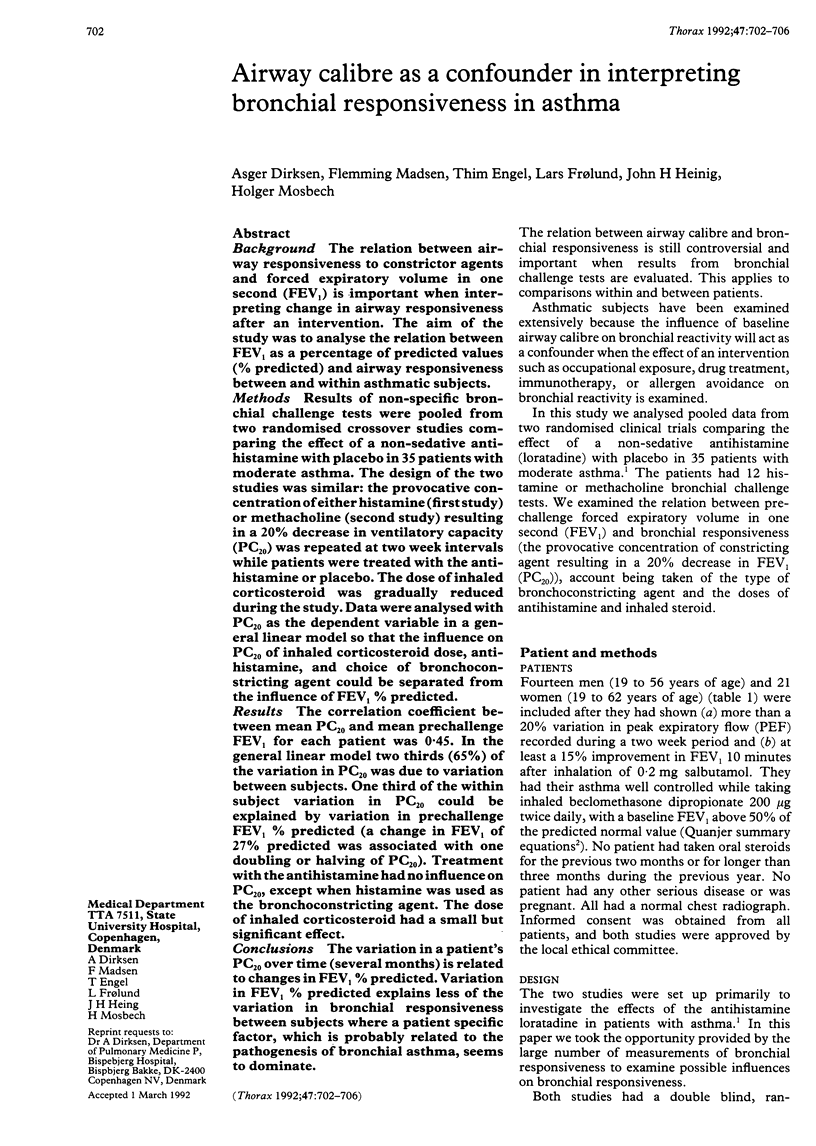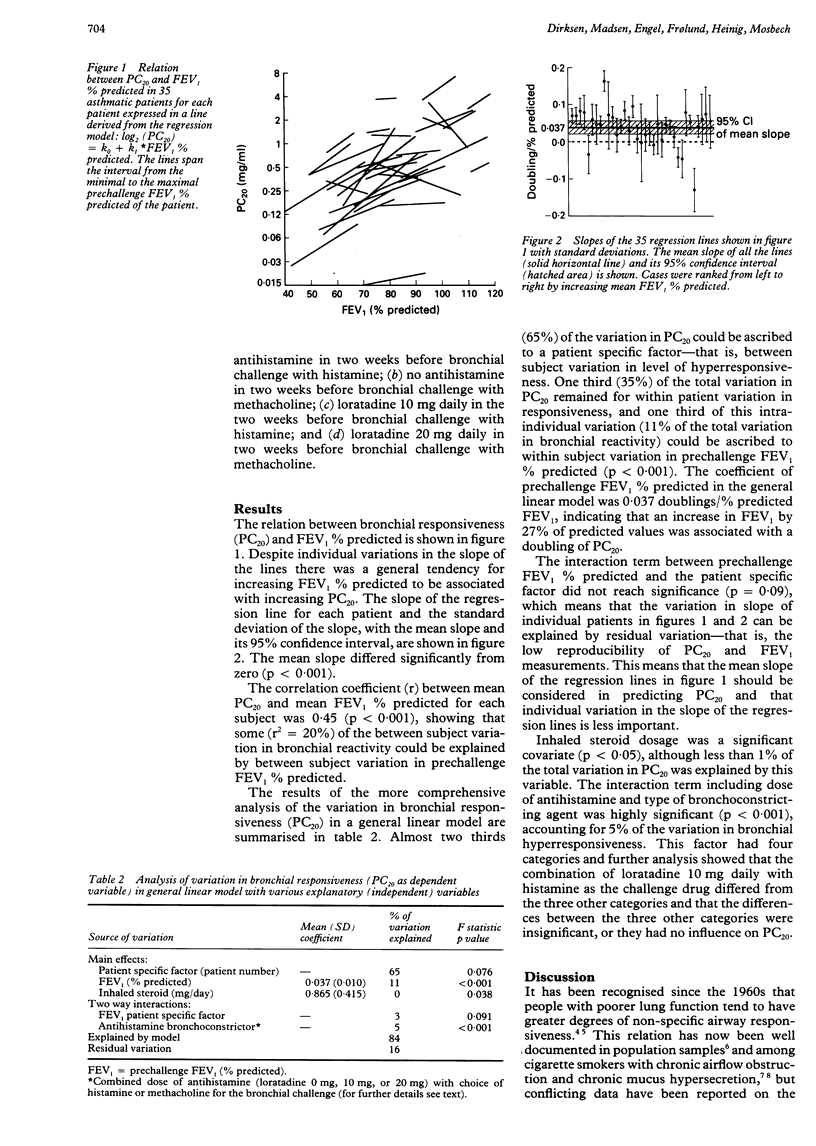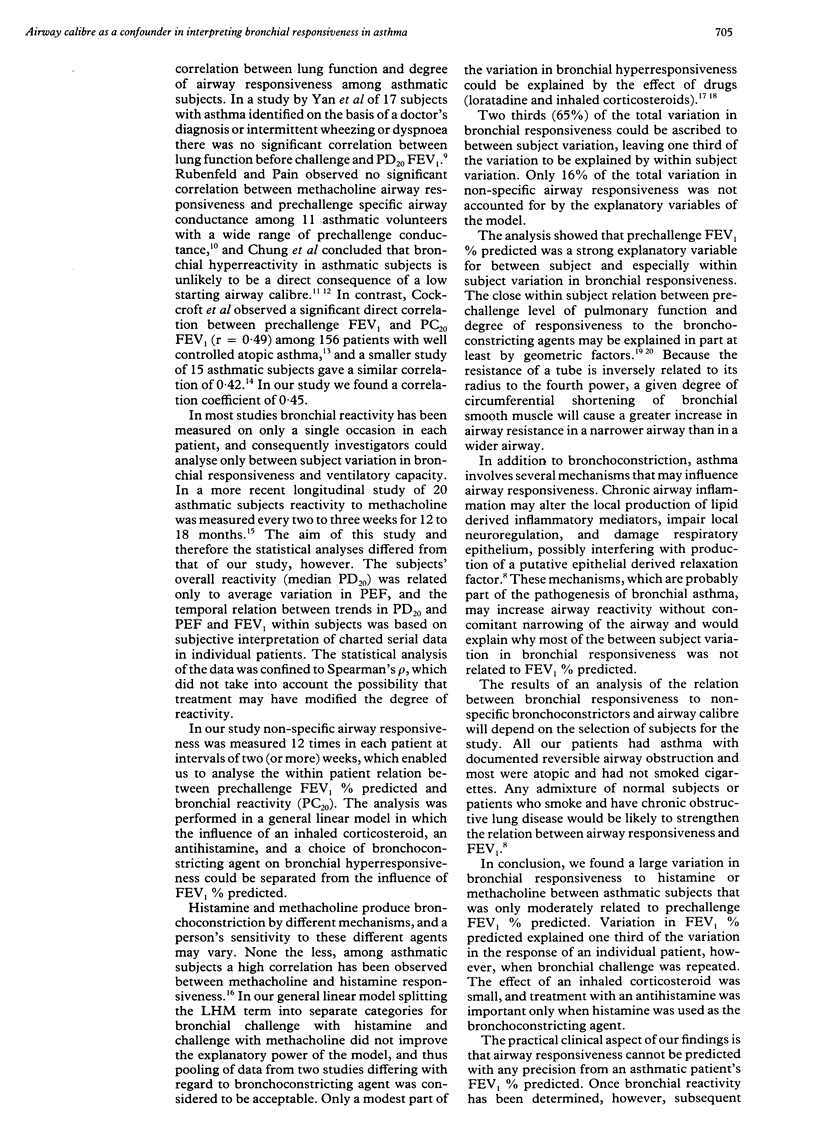Abstract
BACKGROUND: The relation between airway responsiveness to constrictor agents and forced expiratory volume in one second (FEV1) is important when interpreting change in airway responsiveness after an intervention. The aim of the study was to analyse the relation between FEV1 as a percentage of predicted values (% predicted) and airway responsiveness between and within asthmatic subjects. METHODS: Results of non-specific bronchial challenge tests were pooled from two randomised crossover studies comparing the effect of a non-sedative antihistamine with placebo in 35 patients with moderate asthma. The design of the two studies was similar: the provocative concentration of either histamine (first study) or methacholine (second study) resulting in a 20% decrease in ventilatory capacity (PC20) was repeated at two week intervals while patients were treated with the antihistamine or placebo. The dose of inhaled corticosteroid was gradually reduced during the study. Data were analysed with PC20 as the dependent variable in a general linear model so that the influence on PC20 of inhaled corticosteroid dose, antihistamine, and choice of bronchoconstricting agent could be separated from the influence of FEV1% predicted. RESULTS: The correlation coefficient between mean PC20 and mean prechallenge FEV1 for each patient was 0.45. In the general linear model two thirds (65%) of the variation in PC20 was due to variation between subjects. One third of the within subject variation in PC20 could be explained by variation in prechallenge FEV1% predicted (a change in FEV1 of 27% predicted was associated with one doubling or halving of PC20). Treatment with the antihistamine had no influence on PC20, except when histamine was used as the bronchoconstricting agent. The dose of inhaled corticosteroid had a small but significant effect. CONCLUSIONS: The variation in a patient's PC20 over time (several months) is related to changes in FEV1% predicted. Variation in FEV1% predicted explains less of the variation in bronchial responsiveness between subjects where a patient specific factor, which is probably related to the pathogenesis of bronchial asthma, seems to dominate.
Full text
PDF




Selected References
These references are in PubMed. This may not be the complete list of references from this article.
- Beaupré A., Malo J. L. Histamine dose-response curves in asthma: relevance of the distinction between PC20 and reactivity in characterising clinical state. Thorax. 1981 Oct;36(10):731–736. doi: 10.1136/thx.36.10.731. [DOI] [PMC free article] [PubMed] [Google Scholar]
- Bel E. H., Timmers M. C., Zwinderman A. H., Dijkman J. H., Sterk P. J. The effect of inhaled corticosteroids on the maximal degree of airway narrowing to methacholine in asthmatic subjects. Am Rev Respir Dis. 1991 Jan;143(1):109–113. doi: 10.1164/ajrccm/143.1.109. [DOI] [PubMed] [Google Scholar]
- Benson M. K. Bronchial hyperreactivity. Br J Dis Chest. 1975 Oct;69(0):227–239. doi: 10.1016/0007-0971(75)90090-x. [DOI] [PubMed] [Google Scholar]
- Chung K. F., Morgan B., Keyes S. J., Snashall P. D. Histamine dose-response relationships in normal and asthmatic subjects. The importance of starting airway caliber. Am Rev Respir Dis. 1982 Nov;126(5):849–854. doi: 10.1164/arrd.1982.126.5.849. [DOI] [PubMed] [Google Scholar]
- Chung K. F., Snashall P. D. Effect of prior bronchoconstriction on the airway response to histamine in normal subjects. Thorax. 1984 Jan;39(1):40–45. doi: 10.1136/thx.39.1.40. [DOI] [PMC free article] [PubMed] [Google Scholar]
- Cockcroft D. W., Killian D. N., Mellon J. J., Hargreave F. E. Bronchial reactivity to inhaled histamine: a method and clinical survey. Clin Allergy. 1977 May;7(3):235–243. doi: 10.1111/j.1365-2222.1977.tb01448.x. [DOI] [PubMed] [Google Scholar]
- Cockcroft D. W., Killian D. N., Mellon J. J., Hargreave F. E. Bronchial reactivity to inhaled histamine: a method and clinical survey. Clin Allergy. 1977 May;7(3):235–243. doi: 10.1111/j.1365-2222.1977.tb01448.x. [DOI] [PubMed] [Google Scholar]
- Dirksen A., Engel T., Frølund L., Heinig J. H., Svendsen U. G., Weeke B. Effect of a non-sedative antihistaminic (loratadine) in moderate asthma. A double-blind controlled clinical crossover-trial. Allergy. 1989 Nov;44(8):566–571. doi: 10.1111/j.1398-9995.1989.tb04201.x. [DOI] [PubMed] [Google Scholar]
- Josephs L. K., Gregg I., Mullee M. A., Holgate S. T. Nonspecific bronchial reactivity and its relationship to the clinical expression of asthma. A longitudinal study. Am Rev Respir Dis. 1989 Aug;140(2):350–357. doi: 10.1164/ajrccm/140.2.350. [DOI] [PubMed] [Google Scholar]
- Juniper E. F., Frith P. A., Hargreave F. E. Airway responsiveness to histamine and methacholine: relationship to minimum treatment to control symptoms of asthma. Thorax. 1981 Aug;36(8):575–579. doi: 10.1136/thx.36.8.575. [DOI] [PMC free article] [PubMed] [Google Scholar]
- Juniper E. F., Frith P. A., Hargreave F. E. Long-term stability of bronchial responsiveness to histamine. Thorax. 1982 Apr;37(4):288–291. doi: 10.1136/thx.37.4.288. [DOI] [PMC free article] [PubMed] [Google Scholar]
- O'Connor G. T., Sparrow D., Weiss S. T. The role of allergy and nonspecific airway hyperresponsiveness in the pathogenesis of chronic obstructive pulmonary disease. Am Rev Respir Dis. 1989 Jul;140(1):225–252. doi: 10.1164/ajrccm/140.1.225. [DOI] [PubMed] [Google Scholar]
- PARKER C. D., BILBO R. E., REED C. E. METHACHOLINE AEROSOL AS TEST FOR BRONCHIAL ASTHMA. Arch Intern Med. 1965 Apr;115:452–458. doi: 10.1001/archinte.1965.03860160078013. [DOI] [PubMed] [Google Scholar]
- Rijcken B., Schouten J. P., Weiss S. T., Speizer F. E., van der Lende R. The relationship between airway responsiveness to histamine and pulmonary function level in a random population sample. Am Rev Respir Dis. 1988 Apr;137(4):826–832. doi: 10.1164/ajrccm/137.4.826. [DOI] [PubMed] [Google Scholar]
- Rubinfeld A. R., Pain M. C. Relationship between bronchial reactivity, airway caliber, and severity of asthma. Am Rev Respir Dis. 1977 Mar;115(3):381–387. doi: 10.1164/arrd.1977.115.3.381. [DOI] [PubMed] [Google Scholar]
- Simonsson B. G. Clinical and physiological studies on chronic bronchitis. 3. Bronchial reactivity to inhaled acetylcholine. Acta Allergol. 1965;20(5):325–348. doi: 10.1111/j.1398-9995.1965.tb03068.x. [DOI] [PubMed] [Google Scholar]
- Tattersfield A. E. Measurement of bronchial reactivity: a question of interpretation. Thorax. 1981 Aug;36(8):561–565. doi: 10.1136/thx.36.8.561. [DOI] [PMC free article] [PubMed] [Google Scholar]
- Yan K., Salome C. M., Woolcock A. J. Prevalence and nature of bronchial hyperresponsiveness in subjects with chronic obstructive pulmonary disease. Am Rev Respir Dis. 1985 Jul;132(1):25–29. doi: 10.1164/arrd.1985.132.1.25. [DOI] [PubMed] [Google Scholar]


